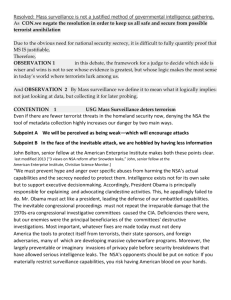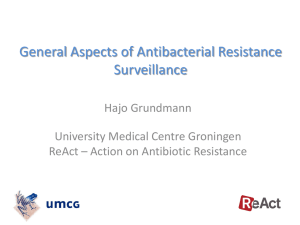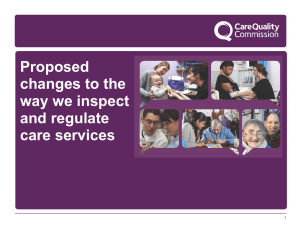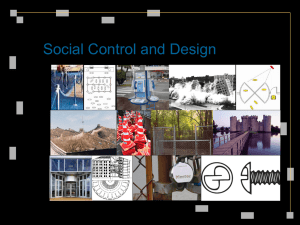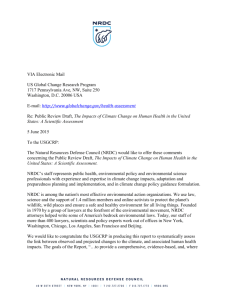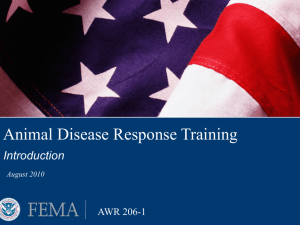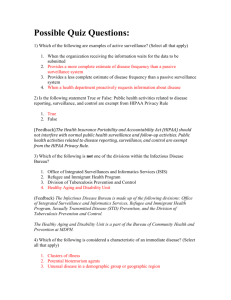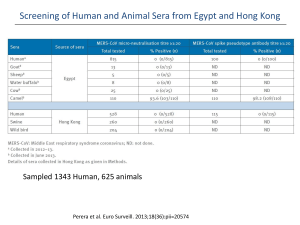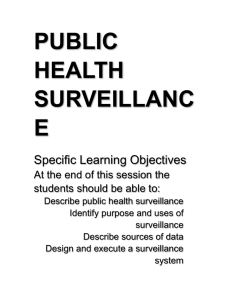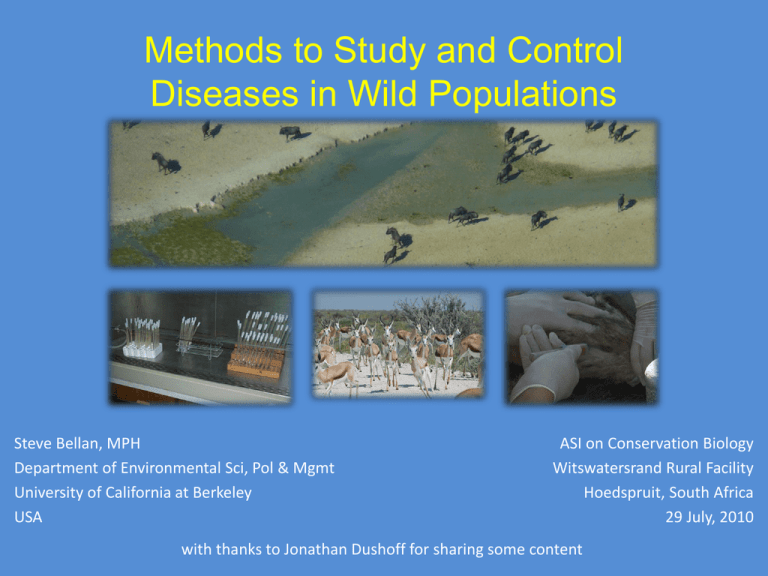
Methods to Study and Control
Diseases in Wild Populations
Steve Bellan, MPH
Department of Environmental Sci, Pol & Mgmt
University of California at Berkeley
USA
ASI on Conservation Biology
Witswatersrand Rural Facility
Hoedspruit, South Africa
29 July, 2010
with thanks to Jonathan Dushoff for sharing some content
Outline
• Surveillance
• Investigation of Pathogen Natural History
• Interventions
• Modeling
Surveillance
• Definition of surveillance
The ongoing systematic collection and analysis of data and
the provision of information which leads to action being
taken to prevent and control a disease, usually one of an
infectious nature.
• Requires diagnostic tools & case definitions
• Active vs passive
• Role of surveillance: What use is it?
• What kind of data can you collect on wildlife & plant diseases?
Recall: Epidemiological Jargon
• Incidence: # of new infections
per unit time
• Prevalence: % of population
infected at particular time
• Seroprevalence: % of population
carrying antibodies indicative of
past exposure
Surveillance: Incidence
• # of new events * host-1 * time-1
• Events can be infection, onset of symptoms, death
• For what diseases is this measureable?
• You must be able to show that it is a new infection!
acute infections (rabies virus, anthrax, others?)
• How do you know it is infected?
diagnostics: laboratory & symptoms
Surveillance: Prevalence
• # proportion of hosts with a specified outcome
• Outcomes: Symptoms, Harboring a pathogen, Seropositivity
• For what diseases is this measureable?
• Prevalence ≈ Incidence * Duration
• So for diseases of short duration, prevalence may be
undetectable.
Surveillance: Mortality
• Definition of surveillance
• Active vs passive
• Role of surveillance
• What kind of data can you collect on wildlife & plant diseases?
–
–
–
–
–
Incidence?
Prevalence?
Seroprevalence?
Mortality?
Pathogen Density?
Surveillance: Seroprevalence
Investigation of Pathogen Natural History
• What is causing the disease?
• How is it transmitted?
• Where, when, and in which animals/plants is it most
problematic?
• Why do we see these population level patterns?
What is causing the disease?
• Identification of the causal agent…Not easy!
• Veterinarians, Pathologists, Microbiologists
• Just because a pathogen is present does not mean it
causes the disease!
• Koch’s Postulates
Koch’s Postulates
(1) The microorganism must be found in abundance in all
organisms suffering from the disease, but should
not be found in healthy animals.*
(2) The microorganism must be isolated from a
diseased organism and grown in pure culture.
(3) The cultured microorganism should cause disease when
introduced into a healthy organism.
(4) The microorganism must be reisolated from the inoculated,
diseased experimental host and identified as being identical to
the original specific causative agent.
How is it transmitted?
• Directly?
• STD?
• Water-borne?
• Vector-borne?
• Vertically?
Where/When is it transmitted?
• Temporal Patterns
– Seasonality
– Recruitment & recurrent epidemics: Rabies
• Spatial Patterns
– Geographic patterns
– Density gradients
– Species Overlap & inter-species transmission
Which individuals are affected?
• Demography
–
–
–
–
Sex
Age
Diet
Behavior
• Population level patterns
– Immunity from history of infection
Prevention & Interventions
• Treatment
• Vaccination
• Culling
• Vector Control
• Direct Pathogen Control
• Reserve Design
What are dynamic models for?
• Rigorously stating hypotheses
• Linking across scales
– We measure disease parameters at the level of individuals
– We are interested in results at the level of populations
– Models are essential for linking these scales because they explicitly
account for dependence of individuals (inherent in infection
processes)
• Exploring the un-explorable
– When ethical, logistical, or resource limitations prevent experimental
or observational studies
Statistical Models
Dynamic Models
• Account for bias and
random error to find
correlations that may imply
causality.
• Systems Approach:
Explicitly model multiple
mechanisms to understand
their interactions.
• Often the first step to
assessing relationships.
• Links observed
relationships at different
scales.
• Assume independence of
individuals (at some
scale).
• Explicitly focuses on
dependence of individuals
By developing dynamic models in a probabilistic framework we
can account for dependence, random error, and bias while
linking patterns at multiple scales.
The SIR model & some extensions
• The basic SIR model
• Mass action vs frequency dependent transmission
• Adding an exposed class
• Realistic waiting time distributions
• Difference equations vs differential equations
• Heterogeneity
• Age structure
This presentation is made available through a Creative Commons Attribution-Noncommercial
license. Details of the license and permitted uses are available at
http://creativecommons.org/licenses/by-nc/3.0/
© 2010 Steve Bellan and the NSF/DIMACS Advanced Study Institute on Conservation Biology, 2010
Title: Disease Ecology Methods
Attribution: the NSF/DIMACS Advanced Study Institute on Conservation Biology, 2010
URL: http://www.cnr.berkeley.edu/getzlab/people/steve_bellan.html
For further information please contact Steve Bellan (sbellan@berkeley.edu).

![2.08-07.0 Impact Measurement Summary []](http://s3.studylib.net/store/data/005836841_1-c1c7f3b79701259d476c9e5ac276fe9d-300x300.png)
